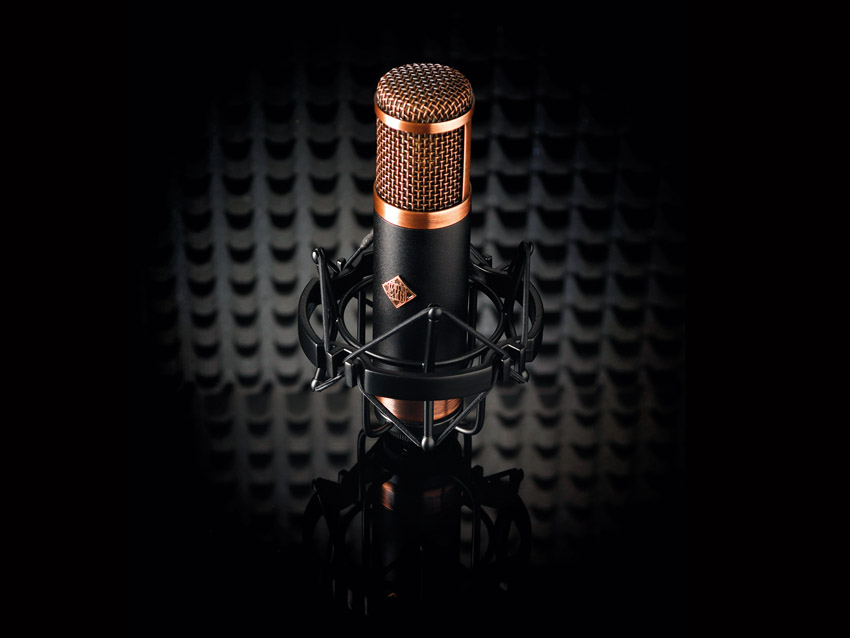MusicRadar Verdict
The CU-29 Copperhead is a classy performer that will capture a transparent and articulate sound.
Pros
- +
Articulate sound. Stunning looks. Telefunken quality at a reasonable price.
Cons
- -
We'd like an aluminium case included at this price.
MusicRadar's got your back
The CU-29 'Copperhead' officially named after the symbol and atomic number for Copper but with a nickname that's synonymous with a venomous snake.
The copper connection comes in because of the distinctive antique copper finish of the grille and other parts attached to the gunmetal body which makes for an extremely attractive looking mic indeed.
The story behind the mic is that Telefunken decided to look into building a cardioid-only valve condenser mic and coincidentally found a cache of about 8,000 NOS (New Old Stock) Telefunken EF-95 valves that were suitable for mic applications.
Consequently the new mic was designed around that particular valve to become part of the company's R-F-T range, which is more affordable than the flagship Telefunken Diamond series and thus more accessible to the small studio or home recordist.
All-new design
As an R-F-T series mic, the CU-29 utilises American-designed electronics combined with standardised parts from overseas manufacturers.
It features a single membrane version of the large diaphragm capsule found in Telefunken's multi-patterned AR-51 and AK-47 mkII mics but where those mics are based on vintage classics. The CU-29 is a unique design that has been developed from the ground up by the in-house design team aided by some knowledgeable consultants.
Power is taken from a remote power supply connected with a 10m seven-pin cable and the microphone comes with a nicely-constructed cradle mount that is easy to tighten up to hold it securely at the desired angle.
The whole shebang comes in a foam-line cardboard box with the mic itself also inhabiting a smart wooden case - we'd have preferred an aluminium carry case for the lot though, especially at this price.
Snake in the studio
First impression of the mic on vocals is that it is extremely articulate - the voice comes through very clearly and precisely with no obvious surfeit or lack of any particular band of frequencies.
The top end is smooth and airy with plenty of presence that's not at all overcooked and there's also a distinct lack of sibilance. Down at the other end the bass is tight and controlled - that's not to say that it's bass-light, just that there's nothing murky or boomy.
There's little doubt that the CU-29 could accurately capture all the nuances of a vocal performance.
On the money
Vocals aside, anyone paying this amount of money for a mic would expect to be able to use it on plenty of other sources and they would not be disappointed.
Checked out on three different types of acoustic guitar, the CU-29 yielded great results with plenty of top end detail. It also did a fine job on electric guitar, placed at various distances from the cab, and recorded hand-held percussion with clarity and accurate reproduction of transients.
Overall impression of the CU-29 is that it's a mic that will accurately record what it 'hears'. If you are looking to spend in excess of a grand on a serious mic, the CU-29 deserves to be listened to.
Future Music is the number one magazine for today's producers. Packed with technique and technology we'll help you make great new music. All-access artist interviews, in-depth gear reviews, essential production tutorials and much more. Every marvellous monthly edition features reliable reviews of the latest and greatest hardware and software technology and techniques, unparalleled advice, in-depth interviews, sensational free samples and so much more to improve the experience and outcome of your music-making.
"At first the tension was unbelievable. Johnny was really cold, Dee Dee was OK but Joey was a sweetheart": The story of the Ramones' recording of Baby I Love You
"This is the amp that defined what electric guitar sounds like": Universal Audio releases its UAFX Woodrow '55 pedal as a plugin, putting an "American classic" in your DAW
"Yamaha has achieved an extraordinary level of immersiveness and realism, crafting an instrument that sounds closer to an acoustic piano and feels like one under your fingers": Yamaha Clavinova CLP-885 digital piano review











